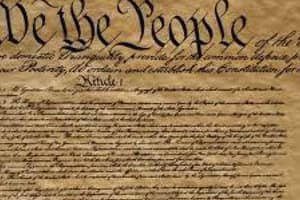Podcast
Questions and Answers
What is the purpose of the system of checks and balances in the U.S. government?
What is the purpose of the system of checks and balances in the U.S. government?
To prevent any one branch of government from becoming too powerful.
In the U.S. Constitution, what power does Congress have in relation to declaring war?
In the U.S. Constitution, what power does Congress have in relation to declaring war?
Congress has the power to declare war.
What landmark Supreme Court case established the principle of judicial review in 1803?
What landmark Supreme Court case established the principle of judicial review in 1803?
Marbury v. Madison
Which Supreme Court case declared segregation unconstitutional in 1954?
Which Supreme Court case declared segregation unconstitutional in 1954?
What is the process for amending the U.S. Constitution?
What is the process for amending the U.S. Constitution?
What process allows for changes to be made to the U.S. Constitution?
What process allows for changes to be made to the U.S. Constitution?
Describe the steps a bill follows to become a law in the U.S.?
Describe the steps a bill follows to become a law in the U.S.?
What was one of the earliest constitutional compromises that shaped the balance of power between branches of government?
What was one of the earliest constitutional compromises that shaped the balance of power between branches of government?
What is the purpose of the two-term limit for U.S. presidents?
What is the purpose of the two-term limit for U.S. presidents?
How can a veto by the president be overcome in the bill becomes a law process?
How can a veto by the president be overcome in the bill becomes a law process?
Study Notes
The US Government and Constitution
The United States is a federal republic with a democratic form of government. At its core lies the U.S. Constitution, which lays out the framework for how the three branches of government - legislative, executive, and judicial - interact with each other. This relationship between these branches creates a system known as the "system of checks and balances," where none of them can become too powerful.
System of Checks and Balances
The Constitution divides powers among the three branches to prevent any one branch from becoming too dominant. For instance, Congress has the power to declare war, but it cannot enforce it without the president's signature. Similarly, while the Senate approves presidential appointments, the House of Representatives has the power to impeach the president. The Supreme Court provides another check through its power to interpret laws and determine if they violate the Constitution.
Landmark Supreme Court Cases
The United States Supreme Court has played a crucial role in shaping American law and society since its establishment in 1789. Some of its most notable decisions include Marbury v. Madison (1803), which established the principle of judicial review; Brown v. Board of Education (1954), where segregation was declared unconstitutional; and Roe v. Wade (1973), which legalized abortion nationwide.
Amendment Process
Despite being one of the oldest constitutions in the world, the U.S. Constitution remains flexible enough to change with the times. Changes are made through the amendment process, whereby Congress proposes constitutional amendments that can then be ratified by three-fourths of state legislatures. As of March 2024, there have been 27 formal amendments to the U.S. Constitution.
Bill Becomes a Law Process
A bill becomes a law after following these steps: introduction, committee hearings, floor debate, vote, conference committee, and presidential signature. However, vetoes by the president and overrides by Congress also play a part in the process.
Constitutional Compromises
To pass important legislation despite disagreements among politicians, compromises were often reached at various points throughout history. These compromises, known as constitutional compromises, helped shape the balance of power between the branches of government and maintain stability within the system. One of the earliest examples is the compromise over slavery, where it was agreed upon that each slave would count as three-fifths of a person for tax and representation purposes. Another example is the two-term limit for presidents, designed to prevent any single individual from having too much control over the country.
Studying That Suits You
Use AI to generate personalized quizzes and flashcards to suit your learning preferences.
Description
Explore the fundamentals of the US government and its Constitution, including the system of checks and balances, landmark Supreme Court cases, the amendment process, bill becomes a law process, and constitutional compromises. Gain insights into how power is distributed among the legislative, executive, and judicial branches.



